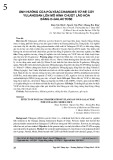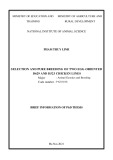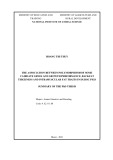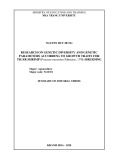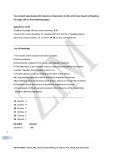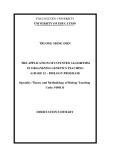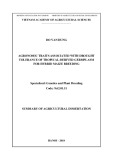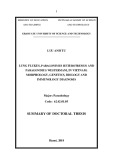Mitochondrial transcription factor A overexpression and base excision repair deficiency in the inner ear of rats with D-galactose-induced aging Yi Zhong1,*, Yu-Juan Hu1,*, Bei Chen1,2, Wei Peng1, Yu Sun1, Yang Yang1, Xue-Yan Zhao1, Guo-run Fan1, Xiang Huang3 and Wei-Jia Kong1
1 Department of Otorhinolaryngology, Union Hospital, Tongji Medical College, Huazhong University of Science and Technology, Wuhan, China 2 Department of Otorhinolaryngology, The First Affiliated Hospital of Zhengzhou University, China 3 Institute of Otorhinolaryngology, Union Hospital, Tongji Medical College, Huazhong University of Science and Technology, Wuhan, China
Keywords age-related hearing loss; DNA repair; mitochondrial common deletion; mitochondrial transcription factor A; oxidative damage
Correspondence W. J. Kong, Department of Otorhinolaryngology, Union Hospital, Tongji Medical College, Huazhong University of Science and Technology, 1277 Jiefang Avenue, Wuhan 430022, China Fax: +86 27 85776343 Tel: +86 27 85726900 E-mail: entwjkong@yahoo.com.cn
*These authors contributed equally to this work
(Received 13 February 2011, revised 21 April 2011, accepted 10 May 2011)
doi:10.1111/j.1742-4658.2011.08176.x
Oxidative damage to mtDNA is associated with excessive reactive oxygen species production. The mitochondrial common deletion (mtDNA 4977-bp and 4834-bp deletion in humans and rats, respectively) is the most typical and frequent form of mtDNA damage associated with aging and degenera- tive diseases. The accumulation of the mitochondrial common deletion has been proposed to play a crucial role in age-related hearing loss (presbycu- sis). However, the mechanisms underlying the formation and accumulation of mtDNA deletions are still obscure. In the present study, a rat mimetic aging model induced by D-Gal was used to explore the origin of deletion mutations and how mtDNA repair systems modulate this process in the inner ear during aging. We found that the mitochondrial common deletion was greatly increased and mitochondrial base excision repair capacity was significantly reduced in the inner ear in D-Gal-treated rats as compared with controls. The overexpression of mitochondrial transcription factor A induced by D-Gal significantly stimulated mtDNA replication, resulting in an increase in mtDNA copy number. In addition, an age-related loss of auditory sensory cells in the inner ear was observed in D-Gal-treated rats. Taken together, our data suggest that mitochondrial base excision repair capacity deficiency and an increase in mtDNA replication resulting from mitochondrial transcription factor A overexpression may contribute to the accumulation of mtDNA deletions in the inner ear during aging. This study also provides new insights into the development of presbycusis.
Introduction
Age-related hearing loss, also known as presbycusis, is a universal feature of mammalian aging, and is the most common auditory disorder in the elderly popula- tion. The etiology of this disease remains unknown, although many genetic and environmental factors have
been shown to be involved in this process [1]. Several investigations in humans have found an association between mtDNA deletions and presbycusis [2,3]. The accumulation of mtDNA deletions in single cells may lead to permanent mitochondrial dysfunction followed
Abbreviations BER, base excision repair; GAPDH, glyceraldehyde-3-phosphate dehydrogenase; OGG1, 8-oxoguanine glycosylase; OHC, outer hair cell; OS, oxidative stress; Pol-c, DNA polymerase-c; ROS, reactive oxygen species; TFAM, mitochondrial transcription factor A; VDAC, voltage- dependent anion channel.
FEBS Journal 278 (2011) 2500–2510 ª 2011 The Authors Journal compilation ª 2011 FEBS
2500
Y. Zhong et al.
Accumulation of mtDNA deletions in inner ear
[4]. However,
human life [16]. Thus, TFAM may be implicated in mutation events. However, a function for TFAM in mtDNA deletion formation has not yet been investi- gated.
by cell death, when the proportion of mutant mtDNA exceeds a certain threshold level the mechanisms involved in the formation and accumula- tion of mtDNA deletions in the inner ear during aging are still obscure.
Mitochondria are
We have previously utilized overdoses of d-Gal to induce OS in vivo, to mimic natural aging of rats [17]. The rats with accelerated aging induced by d-Gal may harbor the mtDNA 4834-bp deletion (also known as the common deletion) in the inner ear as well in as other tissues. Also, the mitochondrial common dele- tion below a certain level may not directly lead to hearing impairment, but may rather act as a predis- posing factor that can greatly enhance the sensitivity of the inner ear to aminoglycoside antibiotics [18]. These findings suggest that the mitochondrial common deletion is an important event in presbycusis. There- it is critical to understand the origin of this fore, lesion and how DNA repair systems modulate this process.
roles
is
In this study, we investigated the effect of BER and mtDNA replication on increased mtDNA mutation loads induced by d-Gal in the inner ear. Our results suggest that two important DNA repair enzymes dur- ing mitochondrial BER, DNA polymerase-c (Pol-c) and 8-oxoguanine glycosylase (OGG1), may play criti- in the formation and accumulation of cal mtDNA deletions in the inner ear. The marked increase in mtDNA replication caused by TFAM over- expression in the inner ear may also take part in this process. Furthermore, we also explored the role of mtDNA deletions in the development of presbycusis.
Results
Age-related accumulation of the common deletion in mtDNA induced by D-Gal
the primary energy-producing organelles in most eukaryotic cells. The inner ear has an abundance of mitochondria, and depends heavily on oxidative energy generated in mitochondria [5]. Reactive oxygen species (ROS) are mostly produced in the mitochondria as a natural byproduct of the normal metabolism of oxygen. Oxidative stress (OS), an imbal- ance between the generation and elimination of ROS, is implicated in oxidative modification of macromole- cules, such as proteins, lipids, and DNA [6]. Mitochon- drial DNA is highly susceptible to damage induced by ROS, because of its close proximity to the sites of ROS generation and its paucity of protective histones [7]. Oxidative damage to mtDNA seems to be unavoid- able during normal aging. Therefore, DNA repair in mitochondria is a crucial step to eliminate mtDNA damage and avoid the accumulation of mtDNA muta- tions. Base excision repair (BER) is the major repair mechanism acting in mitochondria [8]. Although vari- ous reports have focused on the role of BER in removal of so-called small DNA lesions, such as 8-oxo-deoxyguanine, abasic sites (AP site), uracil, and thymine glycol [9,10], very little research has been con- ducted to date on the effect of BER on large-scale mtDNA deletions. In our recent study, we reported that decreased BER activity associated with increased mtDNA deletions in the central auditory sys- tem of rats with d-Gal-induced aging [11]. As is well known, besides the degeneration of the central audi- tory system, the age-related changes of the peripheral auditory system also play an important role in the development of presbycusis. However, as the organ of Corti (part of the peripheral auditory system) is tiny and extremely difficult to dissect, investigations in the peripheral auditory system are much more difficult than those in the central auditory system. Up to now, the effect of BER on large-scale mtDNA deletions in the peripheral auditory system of rats with d-Gal- induced aging is still unknown.
than those of
(P < 0.05)
To evaluate the mtDNA damage induced by d-Gal, the percentage of the mitochondrial common deletion was determined by a quantitative PCR (TaqMan probe) assay. The dual-labeled fluorescent DNA probe was specific for the new fusion sequence, which was present only in mutant mtDNA harboring the com- mon deletion. By applying the specific probe, we can even detect the presence of the common deletion in the inner ear in the control group. The proportions of the common deletion in the inner ear in the low-dose, medium-dose and high-dose groups of d-Gal-treated rats were 9.60% ± 1.46%, 11.31% ± 1.64%, and respectively, which were signifi- 16.03% ± 2.30%, control group the cantly greater (4.35% ± 0.46%) (Fig. 1). Moreover, the deletion burden in the high-dose d-Gal group was
Mitochondrial transcription factor A (TFAM) plays important roles in mtDNA replication and transcrip- tion, and the structure ⁄ organization of mitochondrial nucleoids [12–14]. Moreover, TFAM has been previ- ously reported to modulate BER in mitochondria by virtue of its DNA-binding activity and protein interac- tions [15]. Additionally, relaxed replication of mtDNA within single cells was suggested to be associated with the clonal expansion of single mutant events during
FEBS Journal 278 (2011) 2500–2510 ª 2011 The Authors Journal compilation ª 2011 FEBS
2501
Y. Zhong et al.
Accumulation of mtDNA deletions in inner ear
Increased mRNA level of TFAM induced by D-Gal
To understand whether increased mtDNA proliferation induced by d-Gal was linked to TFAM, we measured the level of TFAM mRNA with a quantitative real- time PCR assay. As shown in Fig. 3, the mRNA levels of TFAM were significantly enhanced in the d-Gal- treated groups as compared with the control group. In comparison with the control group, TFAM expression in the low-dose, medium-dose and high-dose d-Gal groups was increased by 2.5-fold, 3.3-fold, and 5.1-fold, respectively.
Increased protein level of TFAM induced by D-Gal
Fig. 1. Effect of D-Gal on the amount of the mitochondrial common deletion in the inner ear. The percentages of the mitochondrial common deletion in D-Gal-treated groups were significantly higher than in the control group. *P < 0.05, **P < 0.01 versus control group, n = 6. LD, low-dose D-Gal group; MD, medium-dose D-Gal group; HD, high-dose D-Gal group.
(Fig. 4A,B). Figure 4A shows
significantly higher than that in the low-dose d-Gal group (P < 0.05), but there was no difference in the deletion burden between the low-dose and medium- dose groups (P > 0.05).
Mitochondrial DNA proliferation induced by D-Gal
To further understand the expression of TFAM protein in the inner ear, western blot analysis was performed. The protein levels of TFAM in the inner ear of d-Gal- treated rats were significantly higher than those in con- trols representative results for relative abundance of the protein tested. As compared with the control group, the expression of TFAM protein in the inner ear of the low-dose, med- ium-dose and high-dose d-Gal groups was increased by 1.4-fold, 1.7-fold, and 2.5-fold, respectively.
Decreased mRNA levels of DNA repair enzymes induced by D-Gal
low-dose
To investigate the effect of DNA repair enzymes on the mtDNA damage induced by d-Gal, quantitative real- time PCR experiments for the essential BER enzymes, Pol-c and OGG1, were performed. As shown in Fig. 5, mRNA levels of both Pol-c and OGG1 were signifi- cantly reduced in the d-Gal groups as compared with the
To investigate the effect of d-Gal on mtDNA prolifer- ation, we quantified the relative abundance between the mitochondrial D-loop region and a nuclear gene (b-actin) by quantitative PCR assay. As shown in Fig. 2, the relative mtDNA copy numbers in the inner ear were increased by 2.1-fold, 2.5-fold and 3.8-fold in the low-dose, medium-dose and high-dose groups, respectively, as compared with those in controls (P < 0.05). No significant difference was found groups and medium-dose between the (P > 0.05).
Fig. 3. Quantitative analysis of TFAM mRNA expression in the inner ear of experimental groups. The expression levels of TFAM were significantly increased in D-Gal-treated rats as compared with control rats. *P < 0.05, **P < 0.01 versus control group, n = 6. LD, low-dose D-Gal group; MD, medium-dose D-Gal group; HD, high- dose D-Gal group.
Fig. 2. Effect of D-Gal on the amount of total mtDNA in the inner ear. Relative mtDNA copy numbers were significantly increased in D-Gal-treated groups as compared with the control group. *P < 0.05, **P < 0.01 versus control group, n = 6. LD, low-dose D-Gal group; MD, medium-dose D-Gal group; HD, high-dose D-Gal group.
FEBS Journal 278 (2011) 2500–2510 ª 2011 The Authors Journal compilation ª 2011 FEBS
2502
Y. Zhong et al.
Accumulation of mtDNA deletions in inner ear
analysis. The protein levels of Pol-c and OGG1 in the inner ear of d-Gal-treated rats were significantly lower than those in control (Fig. 6A,B). Figure 6A rats shows representative results for relative abundance of the DNA repair enzymes tested. As compared with the control group, the expression of Pol-c protein in the inner ear was reduced by 1.6-fold, 1.9-fold and 4.8-fold in the low-dose, medium-dose and high-dose groups, respectively. OGG1 expression was reduced by 1.8-fold, 2.5-fold, and 2.9-fold, respectively.
Age-related hair cell loss in the inner ear induced by D-Gal
images of hair cells of
Fig. 4. Western blotting and densitometry analysis of TFAM pro- tein expression in the inner ear. (A) Representative western blots show the expression levels of TFAM in different groups. (B) The relative abundance of TFAM protein was significantly increased in the inner ear of D-Gal-treated rats as compared with controls. **P < 0.01 versus control group, n = 12. LD, low-dose D-Gal group; MD, medium-dose D-Gal group; HD, high-dose D-Gal group.
To investigate the effect of mtDNA damage on audi- tory sensory cells, hair cell loss was detected by fluo- rescence microscopy. Hair cell loss was found only in the high-dose d-Gal group. The hair cell loss was limited to outer hair cells (OHCs) at the basal turn of the cochlea. Inner hair cells were generally intact. Figure 7 shows typical the organ of Corti from the high-dose d-Gal group. They were taken from the basal turn, close to the hook region, of a cochlea from one high-dose d-Gal sub- ject. Small amounts of OHC loss are evident in this image.
Fig. 5. Quantitative analysis of Pol-c and OGG1 mRNA expression in different groups. The expression levels of Pol-c and OGG1 were significantly decreased in D-Gal-treated groups as compared with the control group. **P < 0.01 versus control group, n = 6. LD, low- dose D-Gal group; MD, medium-dose D-Gal group; HD, high-dose D-Gal group.
control group. In comparison with the control group, Pol-c expression in the low-dose, medium-dose and high-dose d-Gal groups was decreased by 1.8-fold, 2.5- fold, and 4.8-fold, respectively; OGG1 expression was reduced by 2.4-fold, 3.2-fold, and 3.5-fold, respectively.
Decreased protein levels of DNA repair enzymes induced by D-Gal
Fig. 6. Western blotting and densitometry analysis of Pol-c and OGG1 protein expression in the inner ear. (A) Representative wes- tern blots show the expression levels of TFAM in different groups. (B) The relative abundance of Pol-c and OGG1 protein was signifi- cantly decreased in the inner ear of D-Gal-treated rats as compared with controls. **P < 0.01 versus control group, n = 12. LD, low- dose D-Gal group; MD, medium-dose D-Gal group; HD, high-dose D-Gal group.
To further understand the protein expression of BER enzymes in the inner ear, we performed western blot
FEBS Journal 278 (2011) 2500–2510 ª 2011 The Authors Journal compilation ª 2011 FEBS
2503
Y. Zhong et al.
Accumulation of mtDNA deletions in inner ear
A
B
D
C
Fig. 7. A representive image showing mild OHC loss in the organ of Corti from the high-dose D-Gal-treated group. (A) White light image. (B) Propidium iodide-stained nuclei (red fluorescence). (C) Fluorescein isothiocyanate–phalloidin-stained actin cyto- skeleton (green fluorescence). (D) Merged image of the images shown in (B) and (C). White arrowheads in (A), (B), (C) and (D) indicate the sites of OHC loss. Scale bar: 20 lm.
Discussion
the possible mechanisms involved in the development of presbycusis.
In the present work, we demonstrated significantly increased levels of the mitochondrial common deletion in the inner ear of rats with d-Gal-induced aging. Mitochondrial DNA deletions can accumulate with aging in postmitotic tissues with high energetic demands, such as skeletal muscle, heart, brain, and the inner ear. Therefore, mtDNA deletions have been con- sidered to represent an important molecular marker during aging. Among numerous deletions, the mito- chondrial common deletion (4977 bp and 4834 bp in humans and rats, respectively) is the most typical and frequent form of mtDNA damage associated with aging [23–25]. A recent investigation demonstrated a significant association between the level of the mito- chondrial common deletion in human cochlear tissue and the severity of hearing loss in individuals with presbycusis [26]. Accumulation of the mitochondrial common deletion was proposed to play a critical role in the development of presbycusis. During the aging process, both deleted and wild-type mtDNA can coex- ist in a state called heteroplasmy, but the ratio of mutated to wild-type mtDNA may vary widely between different tissues, and even between cells within
According to Harman’s free radical theory of aging, ROS continuously generated by the mitochondrial electron transport chain are the main contributors to to age-related accumulation of oxidative damage mtDNA [19]. In this study, accelerated aging induced by chronic exposure to d-Gal was associated with oxi- dative stress. Overdose of d-Gal will allow aldose reductase to catalyze the accumulated d-Gal into galactitol, which cannot be metabolized but will accu- mulate in the cell, resulting in osmotic stress and excessive ROS production [20]. Moreover, some stud- ies have indicated that decreased activity of anti- enzymes, advanced glycation end-product oxidant formation, mitochondrial dysfunction, neurotoxicity and apoptosis are also involved in the accelerated aging of d-Gal-treated animals [21,22]. These charac- teristics resemble those of the natural aging process in humans and other animals. As the inner ear tissue is unacquirable during life in humans, and the genetic and environmental background of individuals with hearing loss is inhomogeneous, the investigation of presbycusis is, to some extent, limited. d-Gal-induced aging provides an ideal model with which to explore
FEBS Journal 278 (2011) 2500–2510 ª 2011 The Authors Journal compilation ª 2011 FEBS
2504
Y. Zhong et al.
Accumulation of mtDNA deletions in inner ear
the same tissue. In this study, we also found mild hair loss in the inner ear in high-dose d-Gal-treated cell rats. Our results suggest that the existence of mtDNA deletions does not necessarily imply cochlear damage, but rather that when the level of deletions in a limited number of cells reaches a critical level, cell loss will occur. In the mammalian auditory system, sensory cell loss is the leading cause of hearing loss. Therefore, understanding the mechanism of the formation and subsequent clonal expansion of mtDNA deletions in the inner ear is an essential first step in trying to avoid their occurrence and prevent or delay the development of presbycusis.
organ-specific and region-specific regulation of mito- chondrial BER activities has been observed in C57 ⁄ BL6 mice during aging [33,34]. The level and activity of OGG1 in the liver mitochondrial extract from old mice were found to be higher than those in that from young mice, but a large proportion of the enzyme is stuck to the membrane in the precursor form, and could not be translocated to and processed in the mitochondrial matrix. An age-dependent decline in the mitochondrial import of BER proteins into the mitochondrial matrix may contribute to the increases in damaged bases and mutation load in mitochondria [35]. Our current findings suggest that the age-related cell loss in the peripheral auditory system is probably caused by increased mtDNA damage resulting from mitochondrial BER deficiency in aged rats. This con- cept was supported by the decreased levels of mtDNA repair enzymes and the hair cell loss in rats with d-Gal-induced aging.
Furthermore, replication errors caused by a process known as slip-strand mispairing is the likely mecha- nism behind deletion formation. Several mechanisms for clonal expansion, including selective mechanisms and random genetic drift, have been proposed to explain the high abundance of mtDNA deletions [16,36]. The replication of within individual cells mtDNA with deletion mutations does not occur at the expense of wild-type mtDNA replication, but deleted mtDNA molecules are advantaged [37]. Additionally, treatments that enhance mtDNA replication, such as vigorous excercise, could also amplify the process of the clonal expansion of mtDNA mutations, with potentially detrimental long-term consequences [38]. However, in postmitotic cells such as neurons, there is no cell division, and mtDNA replication frequency is fairly low in these cells. In our study, we found a sig- nificant increase in mtDNA copy number in the inner ear of rats with d-Gal-induced aging. This finding sug- gested that replication of mtDNA is relatively active in the inner ear exposed to d-Gal, although the inner ear is a postmitotic tissue. In addition to mitochondrial BER deficiency, the relatively active mtDNA replica- tion induced by d-Gal exposure, which probably pro- vides more opportunities for replication errors and clonal expansion of mutation events, may partially explain the increased mutation load in the inner ear.
To investigate whether the increased mtDNA muta- tion load is associated with decreased DNA repair capacity in the inner ear, we determined the expression two important BER levels of Pol-c and OGG1, enzymes. Pol-c is the sole DNA polymerase in animal mitochondria, and consists of two subunits: a catalytic subunit, with both polymerase and proofreading 3¢–5¢ exonuclease activity, and an accessory subunit, which confers processivity. A proofreading-deficient version of Pol-c is associated with the accumulation of mtDNA deletions, and premature onset of aging- related phenotypes in knock-in mice [27]. In addition, OGG1 also has a crucial role in the repair of oxidative damage in mammalian mitochondria [28], and it is the primary enzyme for the repair of 8-oxo-deoxyguanine lesions, which constitute one of the major base modifi- cations following oxidative damage to mtDNA [29]. 8-Oxo-deoxyguanine is strongly mutagenic, having the propensity to mispair with adenines, leading to increased frequency of a spontaneous G–C to T–A transversion, which, in turn is related to tumors, aging, and degenerative disease [30]. Using the technique of ligation-mediated PCR, Driggers et al. [31] found that the mitochondrial common deletion could be initiated by persistent oxidative damage in rat mtDNA at a sin- gle guanine at one of the break sites. In OGG1-knock- out mice, the level of 8-oxo-deoxyguanine in the mtDNA was significantly higher than in wild-type mice [28]. In our study, increased mtDNA deletion load and decreased levels of mtDNA repair enzymes (Pol-c and OGG1) were observed in the inner ear of rats with d-Gal-induced aging. The data suggested that the downregulation of mitochondrial BER expression may be an important contributor to increased oxidative mtDNA damage in the inner ear during aging. A pre- vious study in mice also reported that the capacity to repair oxidative DNA damage in various brain regions during aging was altered in an age-dependent manner, and increased mtDNA oxidative damage might con- tribute to the normal aging process [32]. However,
In our study, increases in TFAM expression and dele- tion mutation load were demonstrated in the inner ear of d-Gal-treated rats. The replication of mtDNA is con- trolled by nuclear-encoded transcription and replication factors that are translocated to the mitochondria. Both TFAM and mitochondrial-specific Pol-c are required. TFAM is a key factor involved in directly regulating
FEBS Journal 278 (2011) 2500–2510 ª 2011 The Authors Journal compilation ª 2011 FEBS
2505
Y. Zhong et al.
Accumulation of mtDNA deletions in inner ear
mutation load, and ultimately severe respiratory chain deficiency, in individual cells, followed by cell death.
In conclusion, this investigation demonstrates that a significant decline in mitochondrial BER expression and a remarkable increase in mtDNA replication resulting from TFAM overexpression are involved in the accumu- lation of mtDNA deletion mutations. Enhanced muta- tion load may play a critical role in the development of presbycusis. Avoiding the accumulation of mtDNA mutations may be a useful therapeutic target to prevent or slow the development of presbycusis.
Experimental procedures
Animals and treatment
Eighty-eight male Sprague-Dawley rats (1 month old) were obtained from the Experimental Animal Center of Tongji Medical College, Huazhong University of Science and Technology. After acclimation for 2 weeks, the rats were (n = 22 for each randomly divided into four groups group), depending on the dose of d-Gal (Sigma Chemical, St Louis, MO, USA): low-dose, medium-dose and high- dose groups, and a control group. In the d-Gal groups, rats were injected subcutaneously with 150 mgÆkg)1 (low dose), 300 mgÆkg)1 (medium dose) and 500 mgÆkg)1 (high-dose) d-Gal daily for 8 weeks; control rats were given the same volume of vehicle (0.9% sodium chloride) on the same schedule. All animals were caged at a temperature of 24 ± 2 (cid:2)C in a light-controlled environment with a 12-h light ⁄ dark cycle, and were fed standard rodent chow and water. All experimental procedures were performed under the supervision of our Institutional Animal Care and Use Committee.
DNA extraction
injection, 24 animals (n = 6 from each After the last group) were killed, and bilateral cochleae from each rat were rapidly removed. The membranous labyrinth tissues were then harvested from cochleae with an anatomy micro- scope. Samples were stored at ) 80 (cid:2)C until processing. One side of the cochleae was used for mtDNA analysis, and the other was used for RNA extraction (see below). Total DNA was extracted with the standard SDS–protein- ase K method. The DNA concentration of each sample was assayed with the gene quant pro dna ⁄ rna calculator (BioChrom, Cambridge, UK).
Quantification of the mitochondrial common deletion
The proportion of the mitochondrial common deletion was determined with a TaqMan real-time PCR assay. The
mtDNA copy number in mammals [14]. Additionally, TFAM has a structural role in maintaining mtDNA nucleoid formation [39]. In transgenic mice, overexpres- sion of TFAM was considered to ameliorate age-depen- dent deficits in brain function and mtDNA damage by preventing OS and mitochondrial dysfunction [40]. A sufficient mtDNA copy number is crucial for the mainte- nance of oxidative phosphorylation capacity and, ulti- mately, cell survival. Moreover, increasing the amount of mtDNA has been suggested as a promising therapeu- tic strategy in diseases with mitochondrial dysfunction. It is well known that, within the mitochondria, mtDNA exists as multimolecular clusters in proteinÆDNA macro- complexes called nucleoids. A nucleoid contains two to eight mtDNA molecules, which are organized by the his- tone-like TFAM. However, high mtDNA copy number can also be associated with nucleoid enlargement and defective replication and transcription [41]. Most impor- tantly, abnormal mtDNA copies per nucleoid could interfere with the progression of the mtDNA replisomes, which may cause polymerase stalling and induction of double-strand DNA breaks, two possible mechanisms underlying the formation of mtDNA deletions in humans [42,43]. Ylikallio et al. [41] indicated that nucle- oid enlargement may correlate with defective transcrip- tion, age-related accumulation of mtDNA deletions, and consequent respiratory chain deficiency. Our findings in the present study suggested that increased mtDNA copy number was associated with TFAM overexpression in the inner ear, and that the increased mitochondrial bio- genesis was associated with oxidative stress induced by d-Gal. Increased mitochondrial ROS production has also been reported to be associated with increased muta- tion load and mitochondrial biogenesis in other patho- logical settings [44,45], similar to the age-related one induced by d-Gal treatment in the present study. Such an OS condition may induce increased TFAM levels and increased mtDNA replication as a compensatory response for the decreased mitochondrial functionality. However, it is likely that TFAM overexpression induced by d-Gal is a double-edged sword. TFAM overexpres- sion, as a defense response to dysfunctional oxidative phosphorylation during aging, results in compensatory amplification of mtDNA, which may rescue age-depen- dent impairment in mitochondrial functions [46]; mean- while, increased mtDNA replication may involve clonal expansion of mtDNA deletions and abnormal nucleoid enlargement, which could amplify the effect of mito- chondrial BER deficiency on mtDNA mutations. Taking into account mitochondrial BER deficiency (especially Pol-c defeciency) in the inner ear induced by d-Gal, increased mtDNA replication may be a potential con- tributor to the accelerated accumulation of mtDNA
FEBS Journal 278 (2011) 2500–2510 ª 2011 The Authors Journal compilation ª 2011 FEBS
2506
Y. Zhong et al.
Accumulation of mtDNA deletions in inner ear
forward,
mitochondrial D-loop region is rarely deleted, and the copy number of this region therefore serves as a measure of the total amount of mtDNA in a given tissue sample. The Taq- Man PCR assay primers and probes for mitochondrial D- loop region and common deletion were previously described by Nicklas et al. [24]. The quantitative real-time PCR assay was performed on the ABI Prism 7900HT Fast Real-Time PCR System (Applied Biosystems, Foster City, CA, USA) in a 20-lL reaction mixture containing 4.6 lL of distilled water, 4 lL of sample DNA ((cid:2) 40 ng of DNA), 10 lL of 2· TaqMan PCR mix (Takara, Dalian, China), 0.4 lL of 50· ROX reference dye, 0.4 lL of 10 lm each forward and reverse primer, and 0.2 lL of 10 lm each probe. The ampli- fication conditions were as follows: one cycle of 30 s at 95 (cid:2)C, and 40 cycles of 95 (cid:2)C for 5 s and 60 (cid:2)C for 30 s. Each DNA sample was assayed in duplicate, and data were analyzed with sequence detection software version 2.2 (Applied Biosystems). The abundance of each gene was cal- culated from the cycle threshold (Ct) value, which reflects the PCR cycle number required for the fluorescence signal to reach a set value. The difference in Ct values between the two genes was used as the measurement of relative abundance; DCT (Ctdeletion ) CtD-loop) was used to calculate the abundance of the mitochondrial common deletion, and the proportion of deletion was calculated with the equation R = 2)DCT · 100%.
Mitochondrial DNA copy number assay
with 1 lg of total RNA, with a ReverTra Ace reverse trans- criptase kit (Toyobo Co. Ltd. Osaka, Japan). The RNA and cDNA of each sample were assayed with the gene quant pro dna ⁄ rna calculator to assess concentrations and purification. cDNA samples were stored at ) 20 (cid:2)C until use. Quantitative real-time PCR was performed by applying the real-time SYBR Green PCR technology with the use of a BioRad Opticon 2 genetic analyzer (Bio-Rad Laboratories, Hercules, CA, USA). Validated primers for each gene were designed for each target mRNA. The primer pairs for TFAM, Pol-c, OGG1 and an internal standard [glyceralde- hyde-3-phosphate dehydrogenase (GAPDH)] were as fol- lows: TFAM forward, 5¢-TTGCAGCCATGTGGAGGG-3¢; 5¢-TGCTTTCTTCTTTAGGCGTTT-3¢; TFMA reverse, Pol-c forward, 5¢-CACTGCAGATCACCAATCTCCTG-3¢; 5¢-AGGAGCCTTTGGTGAGTTCAATT- Pol-c reverse, AT-3¢; OGG1 5¢-CGCTATGTATGTGCCA GTGCTAAA-3¢; OGG1 reverse, 5¢-CCTTAGTCTGCGAT GTCTTAGGCT-3v; GAPDH forward, 5¢-GACAACTTTG GTATCGTGGAAGG-3¢; and GAPDH reverse, 5¢-CCAGT AGAGGCAGGGATGATGT-3¢. The amplification condi- tions were as follows: 2 min at 50 (cid:2)C, 2 min at 95 (cid:2)C, and then 40 cycles of 20 s at 95 (cid:2)C, 20 s at 60 (cid:2)C, and 30 s at 72 (cid:2)C. An internal standard was set up to normalize the relative gene expression level, melting curve analysis was performed for each gene, and the specificity and integrity of the PCR products were confirmed by the presence of a single peak. Relative expression was calculated from the differences in Ct values between the target mRNA and an internal stan- dard (GAPDH). The relative mRNA levels between the experimental group and control group was analyzed by using the 2)DDCt method as previously reported [47].
Isolation of mitochondrial protein
Cochleae from 48 animals (n = 12 from each group) were dissected, and pooled membranous labyrinth tissues from the cochleae of three rats were used for each mitochondrial preparation. Mitochondrial protein was extracted with the Tissue Mitochondria Isolation Kit (Beyotime Institute of Biotechnology, China), according to the manufacturer’s instructions. Protein concentrations were determined with the BCA Protein Assay Kit (Pierce Biotech, Rockford, IL, USA), with BSA as standard.
Western blot analysis
The mtDNA copy number was determined by real-time PCR with an ABI Prism 7900HT Fast Real-Time PCR Sys- tem (Applied Biosystems). A nuclear gene (the b-actin gene) was used as an internal control, and the difference in Ct values between the mitochondrial D-loop region and the b-actin gene was used as the measurement of relative abun- dance. The TaqMan PCR assay primers and probes for the mitochondrial D-loop region and the nuclear b-actin gene were previously described by Nicklas et al. [24]. Thermal cycling conditions were as follows: one cycle of 30 s at 95 (cid:2)C, and 40 cycles of 95 (cid:2)C for 5 s and 60 (cid:2)C for 30 s. The mtDNA copy number was calculated from DCt (CtD-loop ) Ctb-actin), where the mean amount of mtDNA per cell = 2 (2)DCt), to account for the two copies of the b-actin gene in each cell nucleus. The mtDNA copy number of the control group was taken as the reference point to calculate the relative mtDNA copy number of the experi- mental group.
RNA preparation and quantitative real-time PCR
FEBS Journal 278 (2011) 2500–2510 ª 2011 The Authors Journal compilation ª 2011 FEBS
2507
The mRNA expression levels of TFAM, Pol-c and OGG1 were determined by quantitative real-time PCR. Total RNA of membranous labyrinth tissues was extracted with Trizol reagent (Invitrogen, Carlsbad, CA, USA), according to the manufacturer’s protocol. cDNA synthesis was performed Mitochondrial protein ((cid:2) 30 lg) was loaded on 15% or 6% SDS ⁄ PAGE gels, and transferred to a poly(vinylidene difluoride) membrane. After protein transfer, the mem- branes were blocked with 5% nonfat milk in NaCl ⁄ Tris and incubated with goat polyclonal antibody against TFAM (1 : 500; Santa Cruz Biotechnology, Santa Cruz, CA, USA), OGG1 (1 : 1000; Abcam, Cambridge, MA, USA), Pol-c (1 : 500; Santa Cruz Biotechnology), and
Y. Zhong et al.
Accumulation of mtDNA deletions in inner ear
anion channel (VDAC)
(No. 2011CB504504)
1 : 3000–1 : 5000. Membranes were
30872865, and 81000409), the National High Technol- ogy Research and Development Program of China (863 Program) (No. 2008AA02Z428), the Major State Basic Research Development Program of China (973 and the National Program) Science and Technology Pillar Program during the Eleventh Five-year Plan Period (No. 2007BAI18B13).
References
(1 : 1000; voltage-dependent Abcam, Cambridge, MA, USA). VDAC, a specific mito- chondrial membrane protein, was used as a loading control for mitochondrial protein. Secondary anti-goat and anti- rabbit IgG (Santa Cruz Biotechnology) was applied at a dilution of then washed, and proteins were visualized with ECL plus (Pierce Biotech). The blots were scanned, and relative band density was analyzed with the gel-pro application (Media Cyber- netics, Silver Spring, MD, USA). The densities were normalized to VDAC.
Morphological analysis of the cochlea
1 Fransen E, Lemkens N, Van Laer L & Van Camp G (2003) Age-related hearing impairment (ARHI): envi- ronmental risk factors and genetic prospects. Exp Gerontol 38, 353–359.
2 Bai U, Seidman MD, Hinojosa R & Quirk WS (1997) Mitochondrial DNA deletions associated with aging and possibly presbycusis: a human archival temporal bone study. Am J Otol 18, 449–453.
3 Markaryan A, Nelson EG & Hinojosa R (2008) Detec- tion of mitochondrial DNA deletions in the cochlea and its structural elements from archival human temporal bone tissue. Mutat Res 640, 38–45.
4 Yin S, Yu Z, Sockalingam R, Bance M, Sun G & Wang J (2007) The role of mitochondrial DNA large deletion for the development of presbycusis in Fischer 344 rats. Neurobiol Dis 27, 370–377.
5 Anniko M & Bagger-Sjoback D (1984) The stria vascularis. In Ultrastructural atlas of the inner ear (Friedmann I & Ballantyne JC, eds.), pp. 184–208. Butterworths, London.
6 Jaruga P & Dizdaroglu M (1996) Repair of products of oxidative DNA base damage in human cells. Nucleic Acids Res 24, 1389–1394. 7 Druzhyna NM, Wilson GL & LeDoux SP (2008)
Mitochondrial DNA repair in aging and disease. Mech Ageing Dev 129, 383–390.
After decapitation, cochleae from 16 animals (n = 4 from each group) were removed immediately from the temporal bones and processed as soft-surface preparations. First, round and oval windows were opened, and the apical portion of the bony cochlea was gently opened to allow the fixative to perfuse through the tissues. Then, the cochleae were per- fused with 4% paraformaldehyde in NaCl ⁄ Pi (pH 7.4), and kept in this medium overnight at 4 (cid:2)C. After fixation, the cochleae were then rinsed in NaCl ⁄ Pi and decalcified in 10% sodium EDTA (adjusted with HCl to pH 7.4) for 5 days or longer as needed. Following decalcification, the softened bony cochlear capsule, stria vascularis, Reissner’s membrane and tectorial membrane were removed under a stereomicro- scope. The basilar membrane was dissected carefully into four or five portions, permeabilized with 0.3% Triton X-100 in NaCl ⁄ Pi for 30 min, and then stained for actin with fluo- rescein isothiocyanate–phalloidin (Sigma-Aldrich, St Louis, MO, USA) at 5 lgÆmL)1 for 50 min. The cochleae were then rinsed three times in NaCl ⁄ Pi for 5 min each, and stained for nuclei with propidium iodide (Sigma-Aldrich) at 50 lgÆmL)1 for 10 min. After several rinses with NaCl ⁄ Pi, the sections of the organ of Corti (base to apex), corresponding to apical, middle and basal portions of the cochlea, were mounted on a slide with antifade mounting media, and imaged with a laser scanning confocal microscope (Olympus, Tokyo, Japan). 8 Bohr VA, Stevnsner T & de Souza-Pinto NC (2002) Mitochondrial DNA repair of oxidative damage in mammalian cells. Gene 286, 127–134. 9 Pons B, Belmont AS, Masson-Genteuil G, Chapuis V,
Statistical analysis
Oddos T & Sauvaigo S (2010) Age-associated modifications of base excision repair activities in human skin fibroblast extracts. Mech Ageing Dev 131, 661–665. 10 Luke AM, Chastain PD, Pachkowski BF, Afonin V,
Data are presented as mean ± standard error of the mean. Analysis was performed with spss 13.0 software (IBM, Armonk, NY, USA). Statistical significance was tested with one-way ANOVA. The least significant difference post hoc test was used to evaluate the differences between two of the groups. Differences with a P-value < 0.05 were considered to be statistically significant. Takeda S, Kaufman DG, Swenberg JA & Nakamura J (2010) Accumulation of true single strand breaks and AP sites in base excision repair deficient cells. Mutat Res 694, 65–71. 11 Chen B, Zhong Y, Peng W, Sun Y, Hu YJ, Yang Y &
Acknowledgements
Kong WJ (2010) Increased mitochondrial DNA damage and decreased base excision repair in the auditory cor- tex of D-galactose-induced aging rats. Mol Biol Rep, doi: 10.1007/s11033-010-0476-5.
This work was supported by grants from the National Nature Science Foundation of China (Nos. 30730094,
FEBS Journal 278 (2011) 2500–2510 ª 2011 The Authors Journal compilation ª 2011 FEBS
2508
Y. Zhong et al.
Accumulation of mtDNA deletions in inner ear
25 Zhong Y, Hu YJ, Yang Y, Peng W, Sun Y, Chen B,
12 Kang D, Kim SH & Hamasaki N (2007) Mitochondrial transcription factor A (TFAM): roles in maintenance of mtDNA and cellular functions. Mitochondrion 7, 39–44.
Huang X & Kong WJ (2011) Contribution of common deletion to total deletion burden in mito- chondrial DNA from inner ear of D-galactose-induced aging rats. Mutat Res, doi: 10.1016/j.mrfmmm. 2011.03.013.
26 Markaryan A, Nelson EG & Hinojosa R (2009) Quanti- fication of the mitochondrial DNA common deletion in presbycusis. Laryngoscope 119, 1184–1189. 13 Maniura-Weber K, Goffart S, Garstka HL, Montoya J & Wiesner RJ (2004) Transient overexpression of mito- chondrial transcription factor A (TFAM) is sufficient to stimulate mitochondrial DNA transcription, but not sufficient to increase mtDNA copy number in cultured cells. Nucleic Acids Res 32, 6015–6027. 14 Ekstrand MI, Falkenberg M, Rantanen A, Park CB,
27 Trifunovic A, Wredenberg A, Falkenberg M, Spelbrink JN, Rovio AT, Bruder CE, Bohlooly YM, Gidlof S, Oldfors A, Wibom R et al. (2004) Premature ageing in mice expressing defective mitochondrial DNA polymer- ase. Nature 429, 417–423. Gaspari M, Hultenby K, Rustin P, Gustafsson CM & Larsson NG (2004) Mitochondrial transcription fac- tor A regulates mtDNA copy number in mammals. Hum Mol Genet 13, 935–944.
15 Canugovi C, Maynard S, Bayne AC, Sykora P, Tian J, de Souza-Pinto NC, Croteau DL & Bohr VA (2010) The mitochondrial transcription factor A functions in mitochondrial base excision repair. DNA Repair (Amst) 9, 1080–1089. 28 de Souza-Pinto NC, Eide L, Hogue BA, Thybo T, Stev- nsner T, Seeberg E, Klungland A & Bohr VA (2001) Repair of 8-oxodeoxyguanosine lesions in mitochondrial dna depends on the oxoguanine dna glycosylase (OGG1) gene and 8-oxoguanine accumulates in the mitochondrial dna of OGG1-defective mice. Cancer Res 61, 5378–5381.
16 Elson JL, Samuels DC, Turnbull DM & Chinnery PF (2001) Random intracellular drift explains the clonal expansion of mitochondrial DNA mutations with age. Am J Hum Genet 68, 802–806. 29 Evans MD, Dizdaroglu M & Cooke MS (2004) Oxida- tive DNA damage and disease: induction, repair and significance. Mutat Res 567, 1–61. 30 Cooke MS, Evans MD, Dizdaroglu M & Lunec J
(2003) Oxidative DNA damage: mechanisms, mutation, and disease. FASEB J 17, 1195–1214. 17 Kong WJ, Wang Y, Wang Q, Hu YJ, Han YC & Liu J (2006) The relation between D-galactose injection and mitochondrial DNA 4834 bp deletion mutation. Exp Gerontol 41, 628–634.
31 Driggers WJ, Holmquist GP, LeDoux SP & Wilson GL (1997) Mapping frequencies of endogenous oxidative damage and the kinetic response to oxidative stress in a region of rat mtDNA. Nucleic Acids Res 25, 4362– 4369. 18 Kong WJ, Hu YJ, Wang Q, Wang Y, Han YC, Cheng HM, Kong W & Guan MX (2006) The effect of the mtDNA4834 deletion on hearing. Biochem Biophys Res Commun 344, 425–430. 19 Harman D (1956) Aging: a theory based on free radical and radiation chemistry. J Gerontol 11, 298–300.
32 Imam SZ, Karahalil B, Hogue BA, Souza-Pinto NC & Bohr VA (2006) Mitochondrial and nuclear DNA- repair capacity of various brain regions in mouse is altered in an age-dependent manner. Neurobiol Aging 27, 1129–1136. 20 Cuatrecasas P & Segal S (1966) Galactose conversion to D-xylulose: an alternate route of galactose metabolism. Science 153, 549–551.
21 Song X, Bao M, Li D & Li YM (1999) Advanced gly- cation in D-galactose induced mouse aging model. Mech Ageing Dev 108, 239–251. 33 Karahalil B, Hogue BA, de Souza-Pinto NC & Bohr VA (2002) Base excision repair capacity in mitochon- dria and nuclei: tissue-specific variations. FASEB J 16, 1895–1902.
22 Lei M, Hua X, Xiao M, Ding J, Han Q & Hu G (2008) Impairments of astrocytes are involved in the d-galac- tose-induced brain aging. Biochem Biophys Res Commun 369, 1082–1087. 34 Gredilla R, Garm C, Holm R, Bohr VA & Stevnsner T (2010) Differential age-related changes in mitochondrial DNA repair activities in mouse brain regions. Neurobiol Aging 31, 993–1002.
23 Meissner C, Bruse P, Mohamed SA, Schulz A, Warnk H, Storm T & Oehmichen M (2008) The 4977 bp dele- tion of mitochondrial DNA in human skeletal muscle, heart and different areas of the brain: a useful biomar- ker or more? Exp Gerontol 43, 645–652. 35 Szczesny B, Hazra TK, Papaconstantinou J, Mitra S & Boldogh I (2003) Age-dependent deficiency in import of mitochondrial DNA glycosylases required for repair of oxidatively damaged bases. Proc Natl Acad Sci USA 100, 10670–10675. 36 Krishnan KJ, Reeve AK, Samuels DC, Chinnery PF,
FEBS Journal 278 (2011) 2500–2510 ª 2011 The Authors Journal compilation ª 2011 FEBS
2509
24 Nicklas JA, Brooks EM, Hunter TC, Single R & Branda RF (2004) Development of a quantitative PCR (TaqMan) assay for relative mitochondrial DNA copy number and the common mitochondrial DNA deletion in the rat. Environ Mol Mutagen 44, 313–320. Blackwood JK, Taylor RW, Wanrooij S, Spelbrink JN, Lightowlers RN & Turnbull DM (2008) What causes mitochondrial DNA deletions in human cells? Nat Genet 40, 275–279.
Y. Zhong et al.
Accumulation of mtDNA deletions in inner ear
37 Herbst A, Pak JW, McKenzie D, Bua E, Bassiouni M & Aiken JM (2007) Accumulation of mitochondrial DNA deletion mutations in aged muscle fibers: evidence for a causal role in muscle fiber loss. J Gerontol A Biol Sci Med Sci 62, 235–245. 42 Wanrooij S, Goffart S, Pohjoismaki JL, Yasukawa T & Spelbrink JN (2007) Expression of catalytic mutants of the mtDNA helicase Twinkle and polymerase POLG causes distinct replication stalling phenotypes. Nucleic Acids Res 35, 3238–3251. 38 Durham SE, Samuels DC & Chinnery PF (2006) Is
selection required for the accumulation of somatic mito- chondrial DNA mutations in post-mitotic cells? Neuromuscul Disord 16, 381–386. 43 Bacman SR, Williams SL & Moraes CT (2009) Intra- and inter-molecular recombination of mitochondrial DNA after in vivo induction of multiple double-strand breaks. Nucleic Acids Res 37, 4218–4226. 44 Balaban RS, Nemoto S & Finkel T (2005) Mitochon- dria, oxidants, and aging. Cell 120, 483–495.
39 Alam TI, Kanki T, Muta T, Ukaji K, Abe Y, Nakay- ama H, Takio K, Hamasaki N & Kang D (2003) Human mitochondrial DNA is packaged with TFAM. Nucleic Acids Res 31, 1640–1645. 45 Trifunovic A & Larsson NG (2008) Mitochondrial dysfunction as a cause of ageing. J Intern Med 263, 167–178. 46 Nishiyama S, Shitara H, Nakada K, Ono T, Sato A,
Suzuki H, Ogawa T, Masaki H, Hayashi J & Yonekawa H (2010) Over-expression of Tfam improves the mito- chondrial disease phenotypes in a mouse model system. Biochem Biophys Res Commun 401, 26–31. 40 Hayashi Y, Yoshida M, Yamato M, Ide T, Wu Z, Ochi-Shindou M, Kanki T, Kang D, Sunagawa K, Tsutsui H et al. (2008) Reverse of age-dependent mem- ory impairment and mitochondrial DNA damage in microglia by an overexpression of human mitochondrial transcription factor a in mice. J Neurosci 28, 8624–8634.
FEBS Journal 278 (2011) 2500–2510 ª 2011 The Authors Journal compilation ª 2011 FEBS
2510
47 Livak KJ & Schmittgen TD (2001) Analysis of relative gene expression data using real-time quantitative PCR and the 2(-Delta Delta C(T)) method. Methods 25, 402–408. 41 Ylikallio E, Tyynismaa H, Tsutsui H, Ide T & Suoma- lainen A (2010) High mitochondrial DNA copy number has detrimental effects in mice. Hum Mol Genet 19, 2695–2705.


